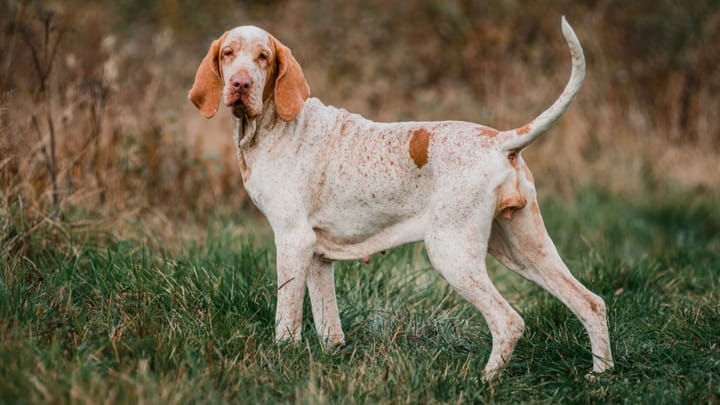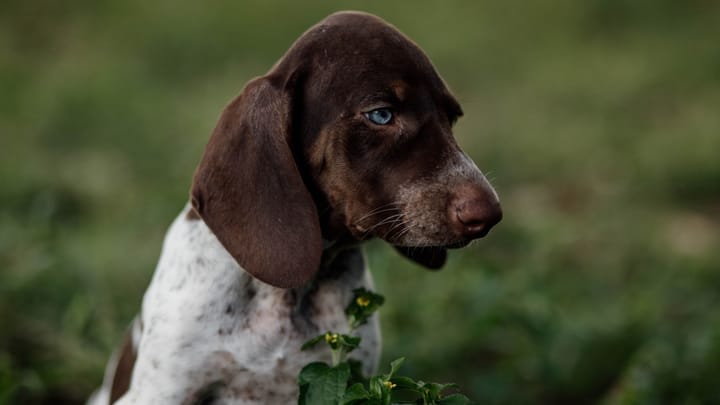Bracco Italiano (Italian Pointing dog)


The Bracco Italiano is a pointer dog that adapts to a number of different hunting styles. Although they are rarely used as pets they prove to be rather docile and affectionate despite their reputation as difficult dogs. Sometimes a little bipolar, they know how to be calm in a family setting but also how to unleash their energy and give it their all at work.
|
Life expectancy |
The Bracco Italiano (Italian Pointing dog) has a life expectancy of between 10 and 14 years |
|
Temperament |
|
|
Size |
Large
|
|
Adult size |
Female
Between 22 and 24 in
Male
Between 23 and 26 in
|
|
Adult weight |
Female
Between 55 and 88 lb
Male
Between 55 and 88 lb
|
|
Coat colour
Their coats can be white-orange in colour: a white body with orange, amber or pale orange markings; brown roan: a white body with solid brown markings or speckles. |
White |
|
Type of coat
The hair is short. Their coat is dense and shiny.
|
Short |
|
Eye colour
Their eyes are brown or ochre and lighter or darker according to the colour of their coat. |
Brown
|
|
Purchase price |
The Bracco Italiano (Italian Pointing dog) costs between £1050 and £1200 |
Going to a good breeder to buy a Bracco Italiano puppy is important. If not, you may end up with a shy or stubborn dog. Today, this dog has been bred to a high standard, in terms of both how they look and their work ethic.
More details about the Bracco Italiano (Italian Pointing dog)
Bracco Italiano (Italian Pointing dog): Origins and history
This is an ancient breed, mainly selected from the North of Italy, this dog was around in the Middle ages and common during the Renaissance. Brunetto Latini described the Bracco Italiano as orange and white in 1260. Their direct ancestors probably come from the Oysel dog, a hunting dog that has been around since the second Crusade. The breed was officially recognised by the FCI in 1956.
Physical characteristics of the Bracco Italiano (Italian Pointing dog)
The Bracco Italiano is built harmoniously, they are a solid dog, noble and elegant. They have a long and supple body, a large neck with a dewlap, a big chest and a robust frame. Their head is angular with an unpronounced stop and divergent craniofacial axes.
With droopy lips and oval eyes, they have a good-natured expression. Their ears are long and dangling sitting towards the back of the head.
FCI classification of the Bracco Italiano (Italian Pointing dog)
-
Group 7 - Pointing Dogs
-
Section 1 : Continental Pointing Dogs
Bracco Italiano (Italian Pointing dog): Characteristics
Bracco Italiano (Italian Pointing dog): Behaviour
Training a Bracco Italiano (Italian Pointing dog)
Originally, because of poor breeding choices, the Bracco Italiano had a reputation for being stubborn and difficult to train. Today, it’s another story, they are very docile, remarkably intelligent and are quick to understand.
However, they are still hunting dogs! With working dogs, nothing is 100% guaranteed. It is important to always stay vigilant, give regular top-up training sessions, and continue to educate them in a way that stimulates them physically and mentally.
Bracco Italiano (Italian Pointing dog): Lifestyle
Breed compatibility Bracco Italiano (Italian Pointing dog)
Bracco Italiano (Italian Pointing dog): Purchase price
The price of a Bracco Italiano varies according to their origins, age and sex. There are not many puppies registered at the Kennel club, so if you are looking to purchase a Bracco Italiano, you might be on a waiting list. They cost on average between £1050 - £1200.
The average budget needed to meet the needs of a dog of this size is about £45 / month.
Bracco Italiano (Italian Pointing dog): Shedding
Light
Their short coat sheds moderately, which is even more obvious during the annual moult. Daily brushing is needed to remove the dead hair.
Bracco Italiano (Italian Pointing dog): Grooming
The Bracco Italiano doesn’t require too much maintenance. They need to be brushed regularly but shouldn’t be bathed nor clipped or shaved.
However, it is important to look after their ears. Dogs with long droopy ears need regular care to stop dirt becoming lodged inside.
Bracco Italiano (Italian Pointing dog): Health
Life expectancy is around 12 years.
This is a hardy dog that is generally in good health.
Be careful with too much physical exertion in the summer: water and a spot in the shade should be readily available.
Their coat and robustness allow them to cope in difficult seasons without a problem.
Their diet needs to be watched and their daily exercise should be physically stimulating so that they don’t succumb to obesity. Very greedy, don’t give in to their demands, even if they turn on those puppy dog eyes.
No particular illness for this dog, they may suffer from various some skin complaints.
Do you want a Bracco Italiano (Italian Pointing dog) dog ?
Oh no...
There are no Bracco Italiano (Italian Pointing dog) adoption profiles at the moment...







